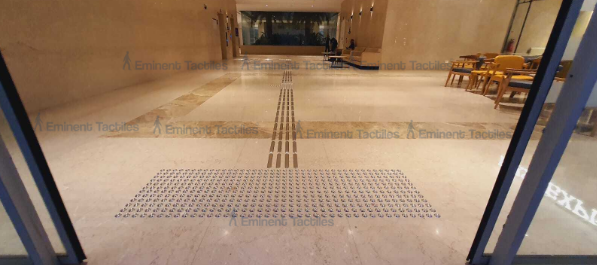In today’s fast-paced world, safety and accessibility are top priorities for public infrastructure. Busy public buildings such as airports, shopping centres, government offices, hospitals, and train stations must be designed to accommodate everyone, including people who are blind or vision-impaired. One powerful tool that supports both safety and inclusivity in such environments is tactile indicators.
What Are Tactile Indicators?
Tactile indicators are specially designed textured surfaces installed on floors to alert or guide pedestrians, especially those with visual impairments. They come in two primary types:
- Warning indicators
- Directional indicators
Why Are Tactile Indicators Essential in Public Buildings?
Busy public buildings often experience high foot traffic, and people move quickly, sometimes in unfamiliar surroundings. Tactile ground surface indicators enhance safety by:
1. Providing Non-Visual Cues for Navigation
People with vision impairment rely heavily on tactile feedback underfoot. Tactile indicators help them identify safe paths, intersections, doorways, and hazards, allowing independent movement through public areas.
2. Reducing Slip and Fall Accidents
Many tactile surfaces are designed to be anti-slip. This is especially crucial in environments like hospital entrances, public restrooms, and station platforms where wet floors or crowded areas increase the risk of accidents.
3. Improving Crowd Management
By guiding pedestrian flow through designated paths, tactile indicators help prevent congestion and improve traffic flow, especially during peak hours in shopping centres, airports, or office buildings.
4. Supporting Emergency Safety
In emergency situations, clear pathways become essential. Directional tactile indicators can assist all users — including those unfamiliar with the environment — to find exits or safe areas quickly and confidently.
Compliance and International Standards
Globally, tactile indicators are not just a best practice — they’re often a legal requirement. Countries like Australia, the United Kingdom, the United States, and many others follow strict accessibility standards such as:
- AS/NZS 1428.4.1 (Australia)
- ADA Standards for Accessible Design (USA)
- BS 8300 (UK)
- ISO 23599 (International Standard for TGSIs)
Where Should Tactile Indicators Be Installed?
In busy public buildings, tactile indicators must be installed at specific, high-risk or high-traffic areas where people — particularly those with vision impairment — need additional sensory cues to move safely and independently. These installations are not only functional but also critical for compliance with global accessibility standards.
1. Stairways and Escalator Entrances
Stairs and escalators pose a major tripping or falling hazard, especially for those who cannot visually detect elevation changes. Installing warning tactile indicators with raised domes just before the beginning and end of a staircase or escalator warns users to stop, reassess, and prepare for a change in level.
2. Elevator Lobbies
Elevator areas are often busy and require clear identification for people who are blind or vision-impaired. Tactile indicators placed just in front of elevator doors allow users to detect the location of the lift entrance. In larger lobbies or open-plan buildings, directional tactile tiles may also be used to guide users from the hallway or entrance area directly to the elevator.
3. Building Entrances and Exits
The entry and exit points of any public building must be clearly marked for orientation. Vision-impaired individuals may need to know where the transition between indoor and outdoor spaces occurs. Tactile indicators help define this threshold, especially when the doorways lead to or from a busy street, parking area, or open plaza.
4. Ticketing and Service Counters
Places such as transport hubs, government buildings, and public service offices often have service counters for inquiries, ticketing, or payments. Directional tactile indicators help guide users toward these counters, especially in wide lobbies where clear pathways may be visually undefined.
5. Pedestrian Crossings and Walkways
Indoor walkways that lead to different sections of a building — such as from reception to various departments — must be marked with directional indicators to help users follow safe, linear paths. At pedestrian crossings within or outside the building (for example, in large hospital or university campuses), warning indicators are installed at the kerb or crossing start point to signal the need for caution before proceeding into traffic zones.
6. Transit Platform Edges
In transport-related public buildings such as railway stations, bus terminals, and metro systems, platform edges pose a severe risk of falls. Warning tactile indicators are installed along the edge of train platforms or boarding areas to alert passengers when they are close to the drop-off zone.
7. Toilets and Amenities
Public restrooms, drinking fountains, lockers, and other amenities must be accessible and easy to locate for all users. Directional tactile indicators can be used to guide users to these amenities, especially when located in long hallways or around corners. Additionally, braille room signs and appropriate luminance contrast in the floor surface can enhance the visibility and usability of these essential services.
Choosing the Right Tactile Solution
There’s no one-size-fits-all approach when it comes to tactile indicators. Material selection, design, installation method (surface-mounted or in-ground), and environmental conditions all influence the best product for the space. Here’s a brief comparison:

Final Thoughts
Incorporating tactile ground surface indicators into public buildings is more than an accessibility feature — it’s a safety measure that protects all visitors. Whether you’re designing a new facility or retrofitting an existing one, installing tactile indicators in a busy public building can significantly reduce the risk of injury, support independent navigation for vision-impaired individuals, and ensure compliance with international accessibility standards.

